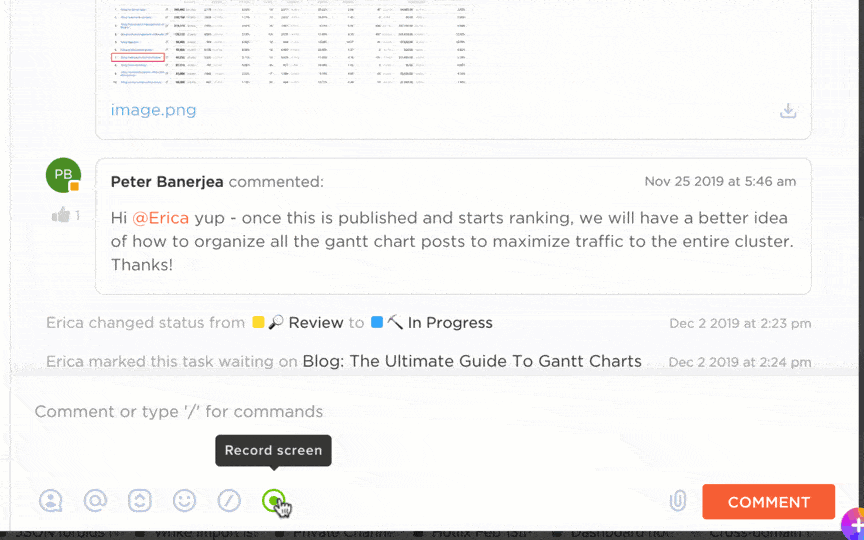The Ultimate Guide to Creating Step-by-Step Instructions Like a Pro

Sorry, there were no results found for “”
Sorry, there were no results found for “”
Sorry, there were no results found for “”
Your team members are excited to use a new software that promises to boost productivity. But instead of hitting the ground running, they’re confused because there’s no clear guide on using it. As a result, the tool sits underutilized, and your team’s performance takes a dive.
Step-by-step instructions can transform this chaos into a streamlined, efficient process.
With detailed, easy-to-follow instructions, your team can confidently navigate new tools and tasks, minimizing downtime and maximizing productivity. They also reduce the learning curve, prevent errors, and keep everyone on the same page, making transitions to new tools or processes smoother and more effective.
This guide outlines how to craft step-by-step instructions that clarify processes, improve knowledge sharing, and boost efficiency.
A step-by-step instruction is a clear, detailed guide that breaks down a process into easy, sequential actions. Each step is straightforward and actionable, taking you from start to finish without missing crucial details.
It’s like having a personal guide that adapts to your pace, ensuring even beginners can follow along confidently and efficiently.
Step-by-step instructions aren’t just nice to have—they’re essential. Here’s why:
To nail step-by-step instructions, you need the right elements. Let’s break them down:
Now, let’s discuss the key scenarios where step-by-step guides really make an impact.
When new hires come on board, they need detailed instructions to familiarize themselves with your company’s policies and their new role. This approach ensures they understand the onboarding process and learn everything they need efficiently.
Further, a clear roadmap with all the details reduces guesswork, mistakes, and integration friction, leading to happier, more engaged team members.
The ClickUp Employee Onboarding Template simplifies onboarding from day one through the first 90 days. It provides clear, step-by-step instructions to help new employees understand their roles and company policies easily.
If you’re onboarding a new marketing manager, you can use this template in the following ways:
This ensures that each step is completed on schedule, making their transition smooth and well-organized.
Customer onboarding involves guiding users through your product using procedures and policies. While some features might be intuitive, standard operating procedures are crucial for setting up, navigating, and getting the most out of your product.
The ClickUp Customer Onboarding Template provides a clear, step-by-step framework to streamline the onboarding process, making it quick and easy to get new customers up and running.
With this template, you can:
Transform complex tasks into clear, actionable steps with detailed work instructions. Outline what needs to be done, the materials and tools required, safety information, and actionable steps for each task. This allows your team to perform organizational tasks efficiently and safely, mastering each job quickly.
The ClickUp Procedure Template is a game-changer for streamlining workflows and maintaining consistency. With just a few clicks, it lets you document every step, track tasks effortlessly, and save hours while reducing errors.
This template is packed with multiple features, including:
💡Pro Tip: Use work instruction templates to standardize process documentation for performing a specific organizational task
Encourage knowledge sharing across your organization through detailed, step-by-step instructions. This way, any employee can easily follow processes and tasks. It helps you make the most of your team’s expertise and avoid losing valuable knowledge when people move on.
The ClickUp HR Knowledge Base Template is an excellent example for streamlining your HR processes.
It allows you to:
Ready to streamline your processes? Here’s how to create effective step-by-step guides that get results.
Clear and concise instructions don’t just happen—they result from careful planning. Here’s how to get it right:
Whether you’re mapping out a complex process or just need a quick guide, ClickUp is your go-to project management tool for nailing step-by-step instructions.
It allows you to easily add screenshots, videos, and other media and collaborate with your team in real time. Its drag-and-drop features simplify organizing your guides, while templates save you time on formatting. Plus, the rich text editing, task tracking, and easy sharing options make it effortless to create, refine, and distribute your step-by-step guides—all in one place.
You’ve got your topic. Now, the real work begins—turning your rough ideas into polished, impactful content. Here’s how to make the magic happen:

Use ClickUp Docs to create one document where you, your team, and subject matter experts can seamlessly draft, edit, and collaborate on content in real time.
Further, you can leverage ClickUp Brain to draft outlines and content for your how-to guides. It also extracts key insights from your existing process documentation, saving time and boosting efficiency.
The AI writing assistant checks the spelling and grammar of your content, rephrases text, and summarizes long paragraphs for clear, precise content. Further, the AI Project Manager enhances team collaboration by auto-generating standups, summarizing comments, and keeping everything streamlined and efficient.

Without proper formatting, even the best content can become a confusing mess. Here’s how to structure your writing for clarity:
In ClickUp Docs, you can add headings, bullet points, numbered lists, and visual elements to make your guide more user-friendly. The extensive formatting options let you use different header styles to organize sections, splash in colors to highlight key points, and pick fonts that fit your requirements.

Now is the moment of truth.
When a series of written instructions falls short, ClickUp Clips can be an excellent alternative. For instance, you can replace parts of your step-by-step guide with detailed training videos. Capture the step-by-step process directly from your screen and share instant demos, updates, and feedback—all with one click.
The best part? ClickUp Brain automatically transcribes your Clips, letting you scan highlights, jump to specific timestamps, and copy snippets for quick access and easy reference.

Now that you know ClickUp is a powerhouse for creating step-by-step guides, let’s see how to make one yourself:









With a fast-growing business, keeping your team productive can feel overwhelming. That’s where step-by-step instructions come in. They act like a blueprint for your employees to learn new processes and tools without missing a beat.
ClickUp equips you with everything you need to streamline the documentation process for your step-by-step guides. Docs streamline the creation and organization of content, making it easy to update and manage. Brain supports brainstorming and connecting ideas while auto-generating instructions and proofreading templates, simplifying content development. Finally, Clips enable you to create screen-recorded videos (with and without voiceovers), which helps share essential information effectively.
Together, these features ensure that your instructions are comprehensive, aligned, and always up-to-date. Get started with ClickUp for free today.
© 2025 ClickUp